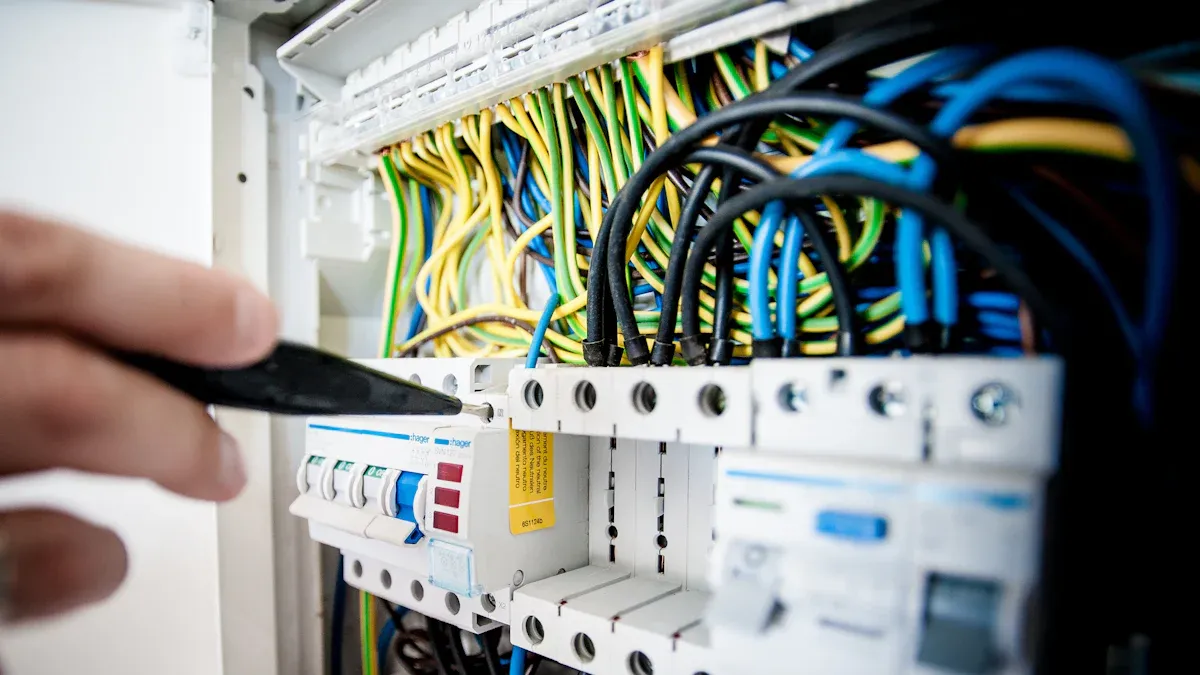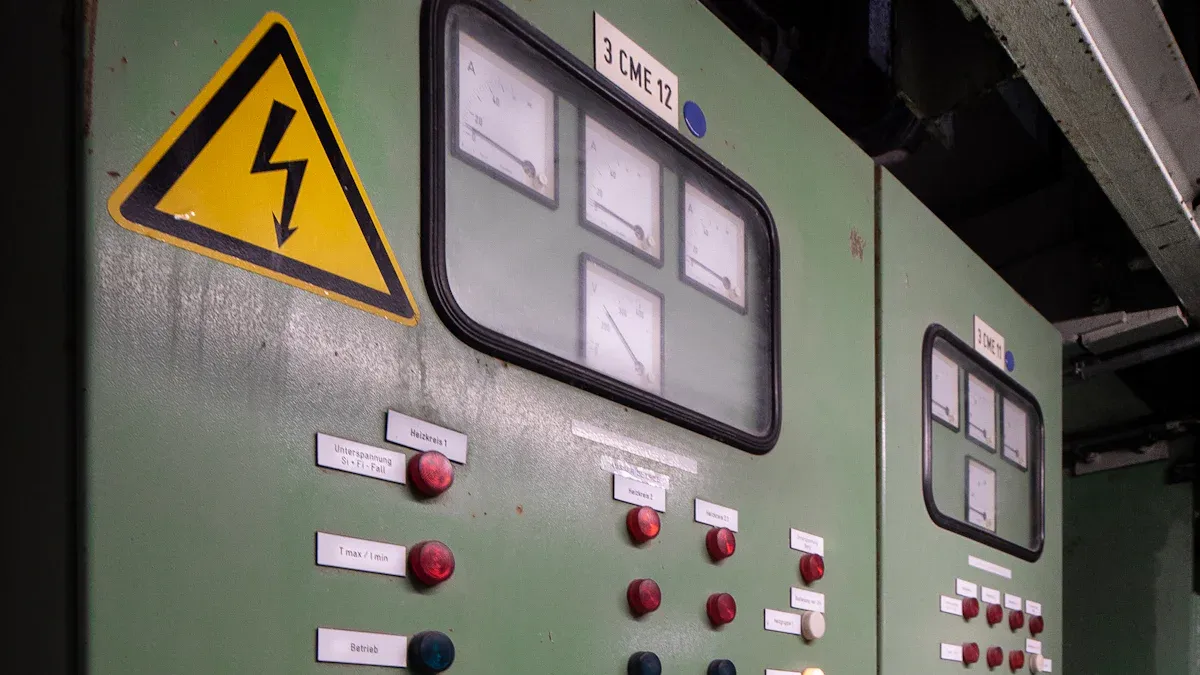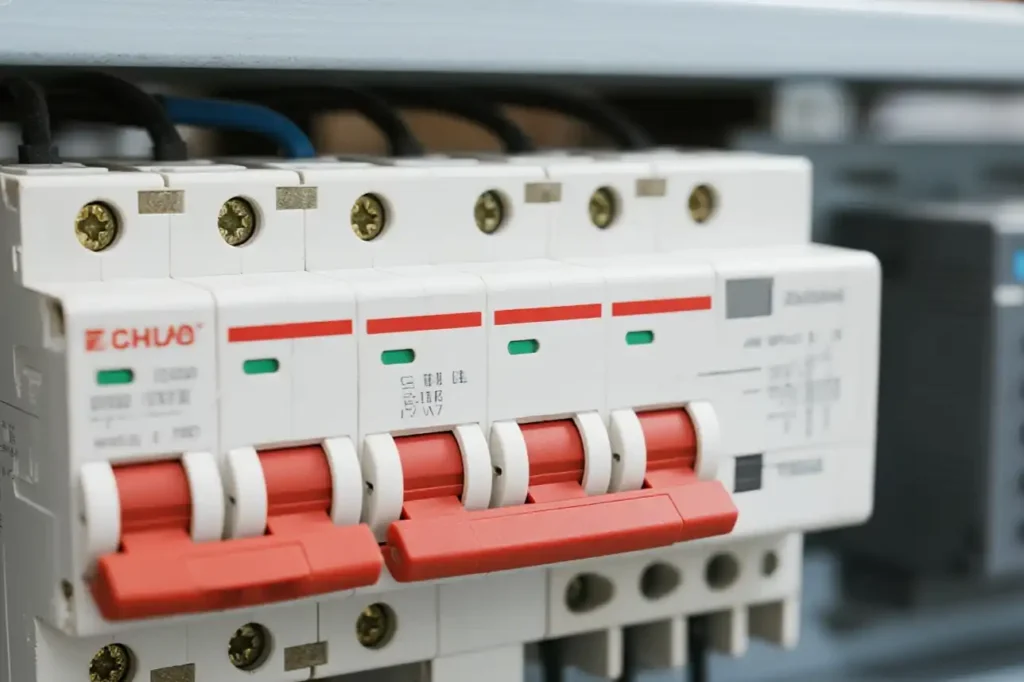You need to use circuit breakers that match the panel manufacturer. This helps keep your home safe and ensures you follow safety regulations. Using the wrong breakers can lead to serious issues:
- Arcing may occur from loose wires or double tapped neutrals.
- Breakers can overheat if they don’t fit properly or are oversized.
- Poor designs can cause breakers to trip unnecessarily.
- Old or incompatible panels increase fire risks.
- You could fail inspections or face problems with insurance claims.
Just because a breaker fits in the panel doesn’t mean it operates safely or complies with the rules set by the panel manufacturer.
Key Takeaways
- You should use circuit breakers that your panel maker approves. This helps keep your home safe. It also makes sure you follow safety rules.
- Look at the panel label and breaker catalog numbers. Check them closely to make sure they match. This helps you avoid fire dangers or problems with inspections.
- If you use the wrong breaker, it can get too hot. It can spark and cause fires. You might lose your warranty and insurance if you do this.
- If you cannot find the original breakers, use UL-listed classified breakers. Talk to experts to help you pick safe options.
- Follow safety steps and ask licensed electricians for help. This keeps your family safe and your electrical system working well.
Why Compatibility Is Essential
Safety Hazards
It is important to use the right circuit breaker for your panel. If you use a breaker that does not match the panel manufacturer, you can have big problems. Bad connections can cause arcing, which might start a fire. Overheating is also a risk. If you see marks, burns, or cracks on breaker casings, something is wrong. These things happen when breakers do not fit well or are not made for your panel.
⚠️ Note: Wires must be tight and secure. If you do not do this, you could have short circuits, overheating, or even a fire.
Here is a table that shows what can go wrong with mismatched breakers:
| Technical Failure | Cause/Description | Consequence |
|---|---|---|
| Overheating | Loose connections or wrong current capacity | Fire hazard, insulation damage |
| Arcing faults | Poor fit or loose wires | Fire risk, insulation damage |
| Breaker failure to trip | Breakers not designed for the panel may not trip during faults | Equipment damage, overheating, melting |
| Breaker loosening | Breakers become loose on the panel bus over time | Loss of connection, overheating |
| Use of aftermarket parts | Non-UL approved breakers not made for the panel manufacturer’s design | Increased risk of failure, unsafe system |
You keep your home and family safe by using breakers that match the panel manufacturer’s rules.
Code Compliance
Electrical codes are made to keep people safe. The National Electrical Code (NEC) and local rules say you must use breakers approved by the panel manufacturer. If you use a breaker not on the list, you break the rules. Inspectors check for this during home inspections. If they find a mismatched breaker, you might not pass.
- Breakers need to be tested and certified for certain panel models.
- Using a breaker not listed for your panel breaks the code.
- Just because a breaker fits does not mean it is approved.
📝 Always look at the panel label and paperwork to see which breakers you can use.
Some panels, like Federal Pacific Electric (FPE), have had safety problems. These panels sometimes do not trip when they should. This can make wires too hot and start fires. Insurance companies and inspectors know about these dangers. They may ask you to change the panel or use only approved breakers.
Insurance and Warranty
Insurance companies want homes to be safe. If you use a breaker that does not match the panel manufacturer, your insurance company might not pay if there is a fire or problem. Some insurance companies will not cover homes with certain panels, like FPE, because they fail a lot. They want you to follow all safety codes and use the right parts.
- Damage from wiring or breakers that do not meet code is often not covered.
- Claims from uninspected or DIY electrical work are usually denied.
- Insurance companies may want you to change panels or breakers before they give you coverage.
Panel manufacturers also have strict rules for their warranties. If you use a breaker from another brand, you might lose your warranty, even if it fits and works. Most manufacturers only promise their own breakers will work in their panels. If you use a classified breaker, check the list, but remember the warranty might not cover it.
💡 Having a licensed electrician install your breakers helps you keep your warranty and insurance.
You save money and avoid trouble by following the panel manufacturer’s rules and using only approved breakers.
Panel Manufacturer Requirements
UL Listing
You need to know why UL listing is important. UL stands for Underwriters Laboratories. They make tough safety rules for electrical products. If a circuit breaker has a UL listing, it passed safety tests for certain panels. UL 489 and UL 1077 are the main rules for circuit breakers. These rules help keep your home safe from electrical problems.
A UL listing is more than just a sticker. It means the breaker works safely with the panel. The National Electrical Code (NEC) says you must use breakers that are listed or labeled for your panel. If you use a breaker not listed for your panel, you could fail inspections. You might also lose your insurance. Some panel makers say not to use UL Classified breakers. But UL says you can use them if you follow the instructions and check the compatibility charts. This helps you find safe choices if the original breaker is not sold anymore.
🛑 Important: Using a breaker without the right UL listing can cancel your warranty and put you in danger.
Approved Breaker Types
You may ask which breakers you can use in your panel. Most panel makers only approve their own brand or certain other brands. They test these breakers for fit, safety, and how well they work. Using the same brand as your panel is usually safest.
Here are some brands that panel makers often approve:
- ONESTOP
- Cutler-Hammer (Eaton)
- Mitsubishi Electric Power Products
- General Electric
- Square D
- Siemens/ITE
You should not use breakers from brands not listed by your panel maker. Even if a breaker fits, it might not be safe. The main thing is brand compatibility, not just the type of breaker. Using approved brands helps protect your home and keeps your warranty good.
Panel Labels
Panel labels tell you which breaker you should use. You can find these labels inside the panel door or on the panel. The label lists the catalog number, electrical ratings, and breaker types you can use. It also shows the short-circuit current rating and other key facts.
UL Solutions says every panelboard must have clear markings. These markings help you and inspectors check if the panel and breakers are safe. The label will tell you if the panel is good for service equipment and which breakers work with it. If you do not follow the label, you could break the rules and have safety issues.
💡 Tip: Always read the panel label before you buy or put in a breaker. The label helps you make safe and legal choices.
You need to match the breaker to the panel maker’s rules to keep your home safe, pass inspections, and keep your warranty. The label and paperwork are your best tools for picking the right breaker.
Identifying Compatible Breakers

Catalog Numbers
You have to check catalog numbers to be sure a breaker fits your panel. Each breaker and panel has its own catalog number. This number shows if the breaker is made for your panel. You can find the catalog number on the breaker and inside the panel door. If the numbers are on the list from the panel maker, the breaker is right for your panel.
📝 Always match the breaker’s catalog number with the list on your panel label. This step helps you avoid mistakes that could cause safety problems or make you fail an inspection.
Some people think any breaker that fits will work. That is not true. You must check the catalog number and see if it is on the list for your panel. If you skip this step, you could have unsafe wiring or break the rules.
Visual Inspection
You can look at the breaker to see if it is right for your panel. Some breakers, like Square D, have a window that shows a flag when it trips. This flag lets you know if the breaker has tripped and helps you see the brand. When you see this flag, you can tell if the breaker matches the panel maker.
Look for these things when you check:
- Brand name or logo on the breaker
- Catalog number and electrical ratings
- Special things like trip indicator windows
🔍 If a breaker has no clear markings or looks damaged, do not use it. Always pick breakers with clear labels and features that match your panel.
Classified Breakers
Sometimes, you cannot find the original breaker from your panel maker. In these times, you might use a classified breaker. Classified breakers are made by another company but have been tested for certain panels. UL checks these breakers to make sure they are safe for some panels.
- Classified breakers are safe if you use the right list and follow the rules.
- They do not cancel your panel’s UL listing or warranty if used as approved.
- Some brands want you to use only their breakers, but UL and the law let you use classified breakers if they are tested and listed for your panel.
Never think a breaker is safe just because it fits. Always check the list and follow the rules. This keeps your electrical system safe and legal.
Risks of Incompatible Breakers

Fire and Arcing
You face serious fire risks when you use breakers that do not match your panel. Incompatible breakers can create poor contact with the bus bar. This poor contact causes arcing, which is a spark that jumps between metal parts. Arcing can melt the metal and plastic inside your panel. Sometimes, this melting spreads to other breakers and starts a chain reaction fire. If a breaker melts or sticks, it may not trip during a short circuit or overload. This lets too much electricity flow, which overheats the panel and can cause a fire behind your walls.
- Loose connections from wrong breakers create heat and sparks.
- Corrosion on aluminum bus bars makes arcing worse.
- Some old brands, like Zinsco, have design flaws that make fires more likely.
- Visual checks may not catch these problems. Thermal imaging can help spot overheating early.
🔥 Warning: Mixing breaker brands or using the wrong type increases the risk of fire and electrical shock.
Failed Inspections
You risk failing electrical inspections if you use incompatible breakers. Inspectors look for breakers that match the approved list for your panel. If they find a breaker that does not belong, they will mark it as a code violation. This can delay your project or sale of your home. You may have to pay for repairs or replacements before you can pass inspection.
- Wrong breakers void the UL listing for your panel.
- Code violations can lead to fines or legal problems.
- Failed inspections can stop home sales or renovations.
Voided Warranty
You lose your warranty when you use breakers not approved for your panel. Manufacturers only cover damage if you use the breakers listed on the panel label. If you use the wrong breaker, you pay for repairs yourself. Warranties do not cover labor or extra damage from incompatible breakers. Some brands, like Square D, clearly state that using unapproved breakers cancels all warranty protection.
- Using the wrong breaker breaks the rules in the installation guide.
- The UL stamp only counts if the breaker is used in the right panel.
- You risk expensive repairs and lose support from the manufacturer.
🛑 Always check the panel label and use only approved breakers to keep your warranty and stay safe.
Solutions When Breakers Are Unavailable
Using Classified Breakers
Sometimes, you cannot find the original breakers for your panel. They might be discontinued or sold out. This can make it hard to stay safe and follow the rules. Classified breakers are a good choice when this happens. Manufacturers and safety groups test classified breakers for certain panels. These breakers help keep your electrical system safe and up to code when you cannot get the original parts.
🛠️ Tip: Always look at the compatibility chart for classified breakers. This chart helps you match the breaker to your panel’s mounting system, model number, and interrupting capacity.
There are other ways to find hard-to-get breakers:
- Some suppliers sell reconditioned or refurbished breakers. These meet industry standards and have warranties.
- Certain companies make replacement parts for old models.
- If no safe breaker fits, you might need custom retrofitting or even a new panel.
- Skilled technicians can help you find the right alternatives.
You keep your home safe and follow the rules by using only tested and listed replacements.
Consulting Professionals
You should talk to professionals if you cannot find the right breaker. Licensed electricians and certified suppliers know the risks of using wrong parts. They understand safety standards and help you avoid expensive mistakes.
| Certification | Purpose | Application |
|---|---|---|
| UL 489 | Primary circuit protection | Main and branch circuits |
| UL 1077 | Supplementary circuit protection | Equipment and sub-circuits |
Ask professionals about these certifications. UL 489 breakers are tested for main protection. UL 1077 breakers give extra protection inside equipment. Local rules may need one or the other. Professionals help you pick the right breaker for your panel and make sure you follow all rules.
💡 Note: Knowing about certifications helps you make safe choices and keeps your electrical system working well.
Safety Precautions
You must follow safety steps when you replace or install breakers. These steps show why safety is important:
- Turn off all power and check with a voltage tester.
- Wear insulated gloves, safety glasses, and other PPE.
- Take off the panel cover only after the power is off.
- Disconnect wires slowly and do not touch live parts.
- Put in the new breaker by following the manufacturer’s instructions.
- Make sure all connections are tight and wires are not exposed.
- Label wires and update the panel directory.
- Test the new breaker before turning the power back on.
⚠️ Warning: Never work on electrical panels without proper training. Always call a licensed electrician if you are unsure.
You lower the risk of shock, fire, and breaking the rules by following these safety steps. Safety protects you, your family, and your home every time you work with circuit breakers.
You keep your home and family safe by using the right circuit breaker for your panel. Research shows that using the wrong breaker can start fires, break equipment, and make insurance not pay.
- Always read the panel label before you put in a breaker.
- If you are not sure, ask a licensed electrician for help.
To make your electrical system safer, do these things:
- Get regular inspections and maintenance done.
- Teach everyone at home how to spot electrical dangers.
- Make sure panels are easy to reach and not blocked.
⚡ Making safe choices now helps you avoid big problems later.
FAQ
Why does using the wrong breaker brand increase fire risk?
Using the wrong breaker can make it not fit tight. Loose connections can make sparks and heat. These things can start a fire in your panel. Always use breaker brands your panel maker lists to stay safe.
Why do inspectors check for breaker compatibility?
Inspectors want to see if your system follows safety rules. If you use the wrong breaker, you might not pass inspection. This keeps you safe from hidden dangers and stops fires or damage.
Why do insurance companies care about breaker and panel brands?
Insurance companies want less risk. Using the wrong breaker breaks safety rules. This can cancel your policy. They may not pay for fire or damage from wrong breakers. Always follow the panel label to keep your insurance.
Why can’t you trust a breaker just because it fits?
A breaker that fits might still be unsafe. Only breakers tested for your panel work right. The wrong breaker may not trip when needed. This can cause overheating, fire, or damage.
Why should you consult a professional before replacing breakers?
You should ask a professional because they know which breakers are safe. They help you avoid mistakes that cause fires or failed inspections. Professionals make sure you follow safety rules and keep your warranty.
See also
Why DC and AC Circuit Breakers Are Not Interchangeable
How to Identify Certified Single Phase MCCB
Essential Checklist for Purchasing Micro-Circuit Breakers
Step-by-Step Guide to Replacing Your Circuit Breaker Panel
UL 489 and UL 1077: Understanding Electrical Protection



